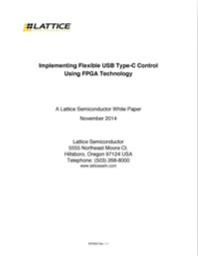Implementing Flexible USB Type-C Control Using FPGA Technology
Type-C interfaces bring dramatic benefits to consumers. However, in order to realize this potential designers must implement Type-C's Power Delivery (PD) protocol, detect cable orientation and switch high speed signals, as needed and, if desired, provide support for Vendor Defined Messaging (VDM).
This whitepaper will show you how low-cost FPGA devices can be used in combination with off-the-shelf USB devices to develop products which take full advantage of the interface's speed, power and versatility, and how they can be brought to market in a rapid manner.
Download this whitepaper to find out more.
Read More
By submitting this form you agree to Lattice Semiconductor Corporation contacting you with marketing-related emails or by telephone. You may unsubscribe at any time. Lattice Semiconductor Corporation web sites and communications are subject to their Privacy Notice.
By requesting this resource you agree to our terms of use. All data is protected by our Privacy Notice. If you have any further questions please email dataprotection@techpublishhub.com
Related Categories: Analog, Communication, Embedded, Power, Processors, Resistors, Switches

More resources from Lattice Semiconductor Corporation
USING LOW COST, NON-VOLATILE PLDS IN SYSTEM APPLICATIONS
System designers are faced with continual pressure to meet their development schedules, and need to implement designs with minimal effort and risk ...
1:2 and 1:1 MIPI DSI Display Interface Bridge Soft IP
As the industry evolves, bandwidth requirements have exceeded what display manufacturers are capable of manufacturing, while application processor ...
CMOS to MIPI D-PHY Interface Bridge Soft IP
MIPI D-PHY is a practical PHY for typical camera and display applications. It is designed to replace traditional parallel bus based on LVCMOS or LV...

